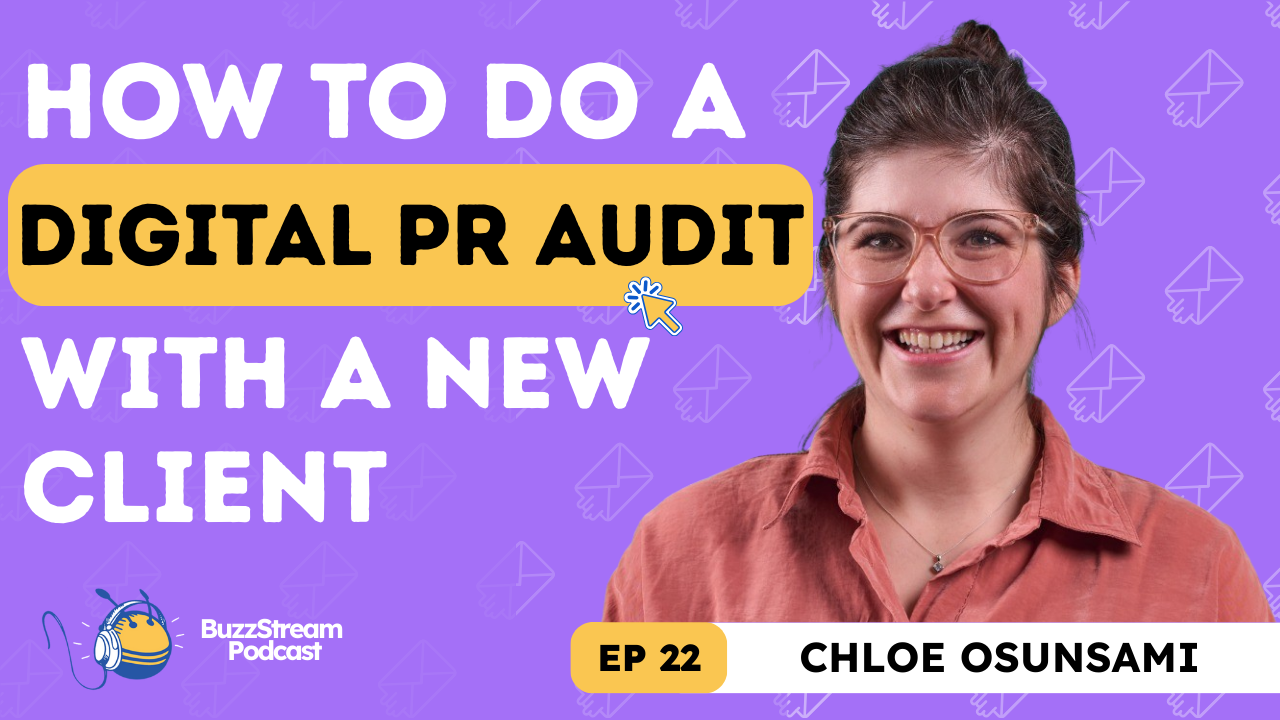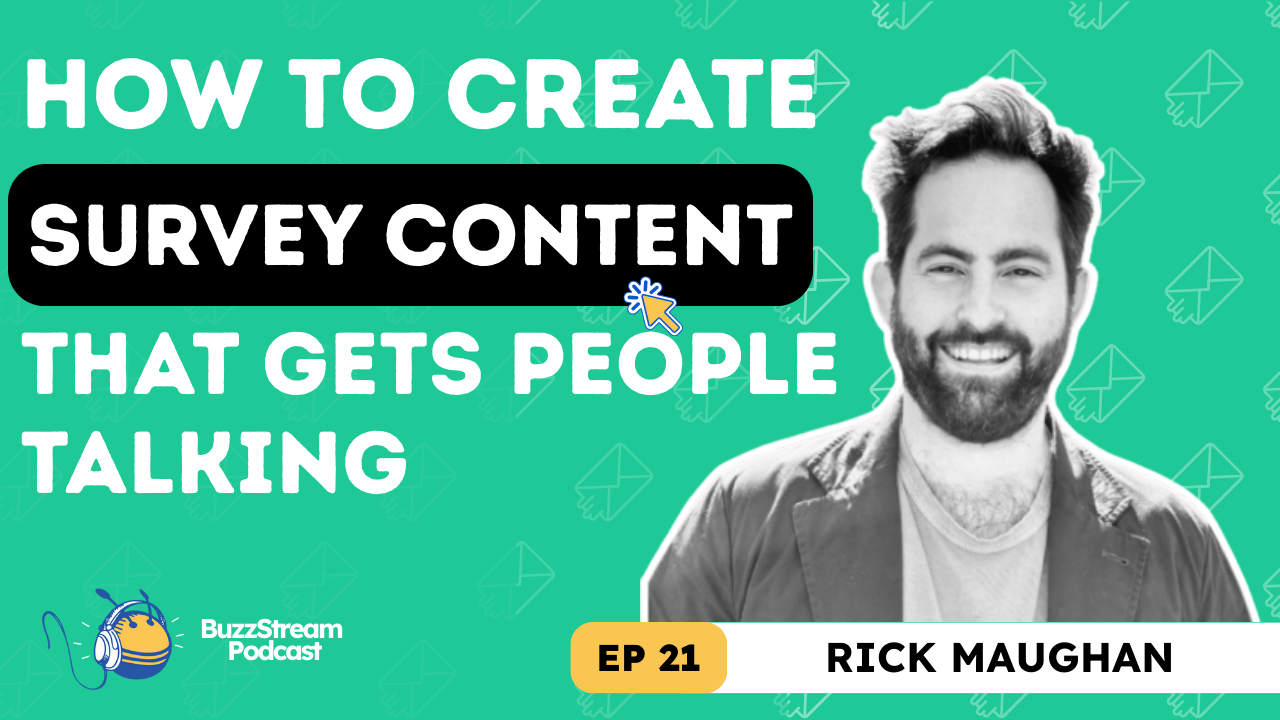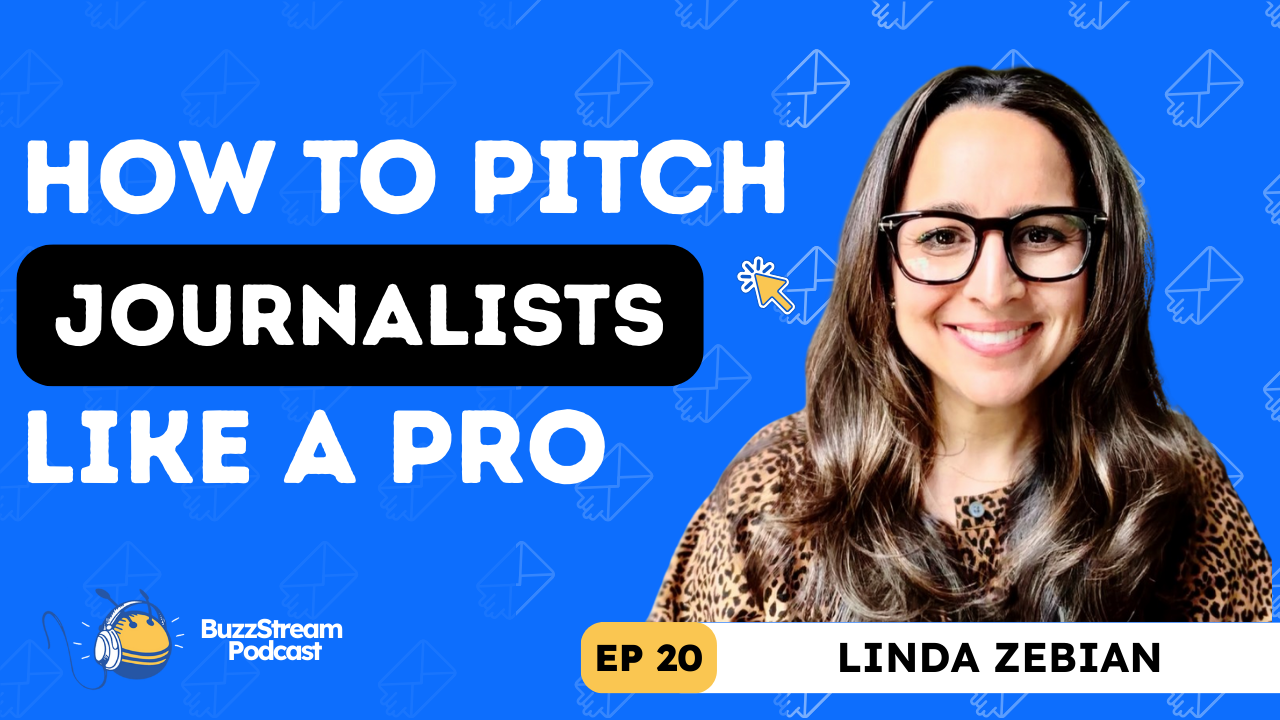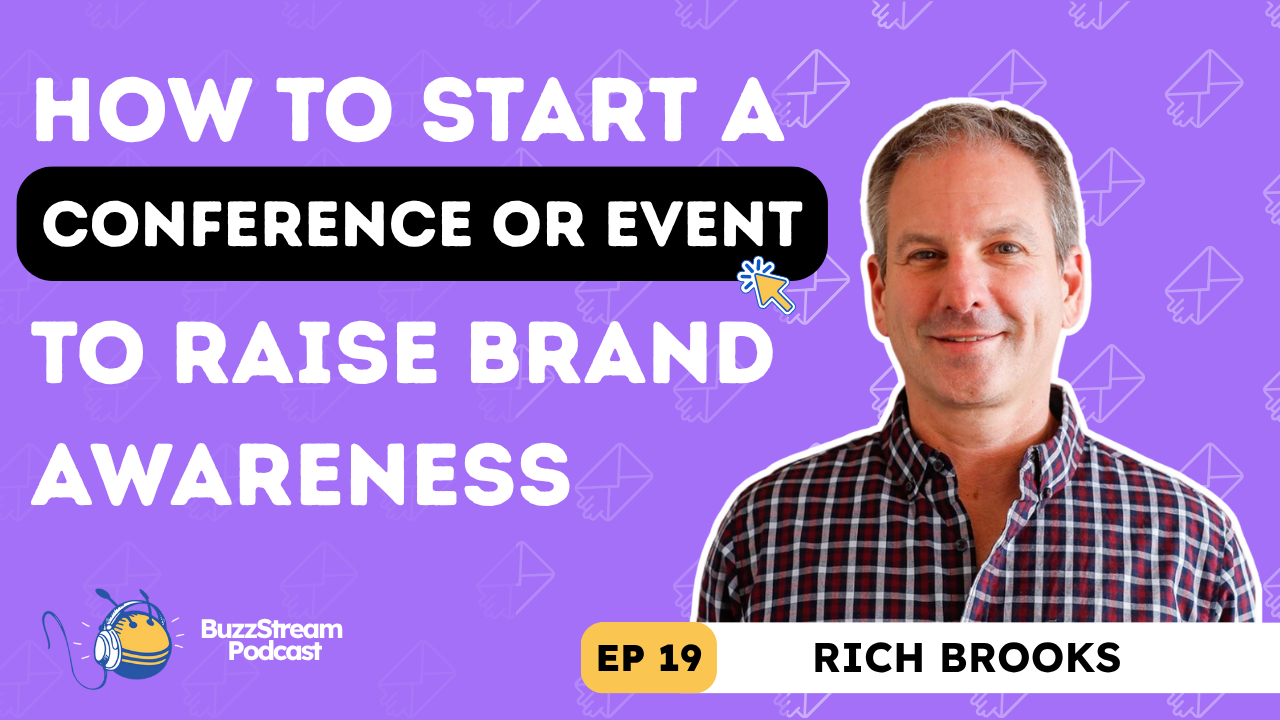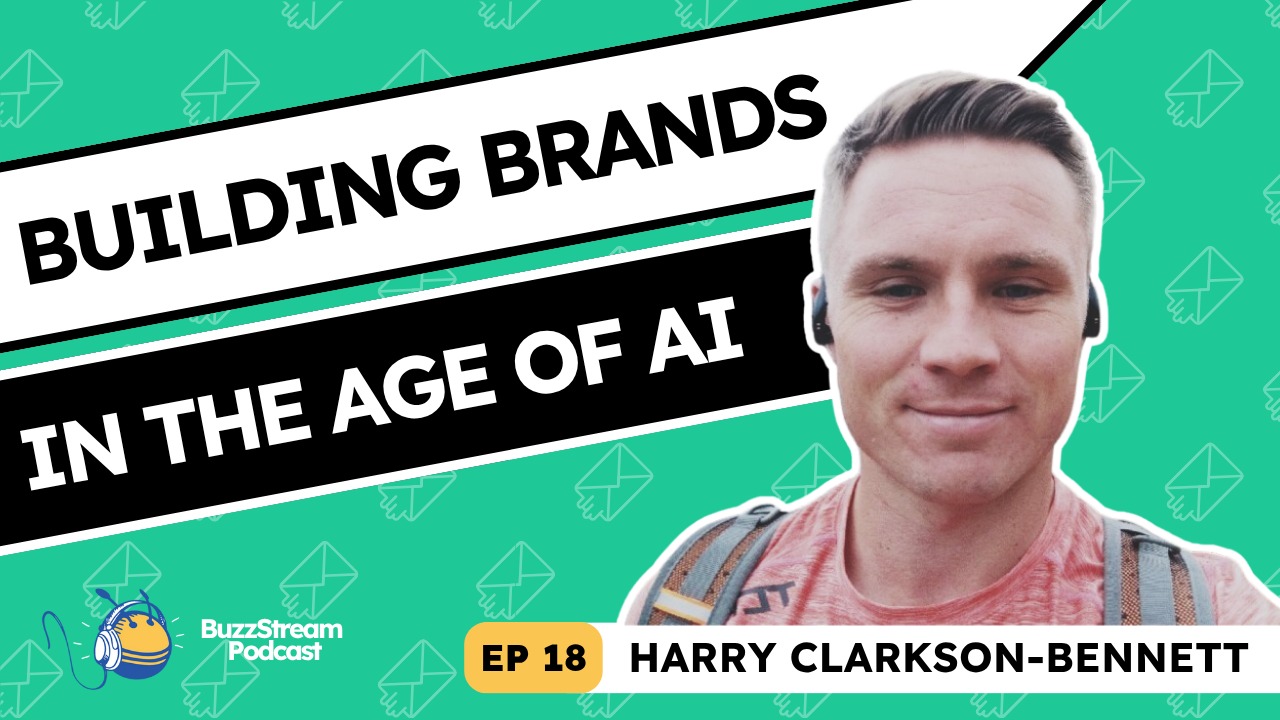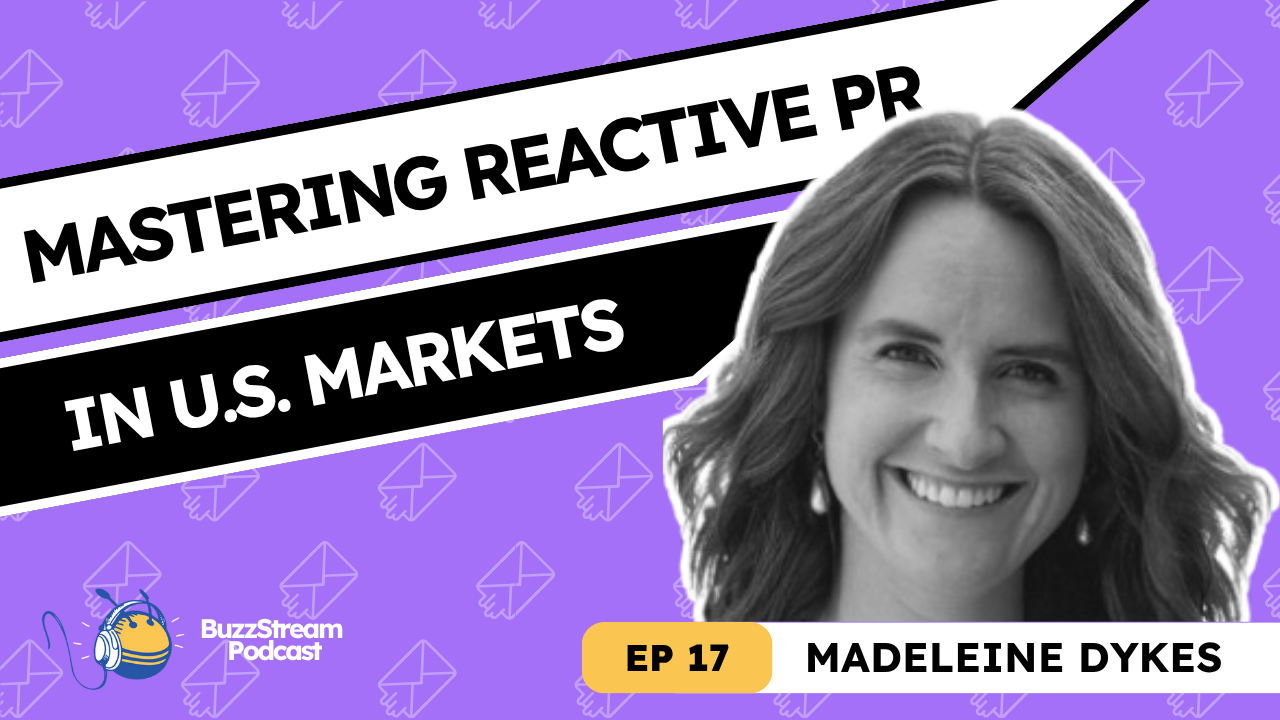Table of Contents
I met Digitaloft’s founder, James Brockbank, at their Digital PR Summit in Manchester.
James immediately struck me as not only an approachable guy but someone who really, really knew his stuff.
With his deep SEO background, he can explain technical aspects like Google’s patents while still naturally integrating that into his agency’s digital PR and content strategy without it feeling forced.
So, when I saw James’ LinkedIn post about “digital PR having a relevancy problem right now” (I suggest reading the full post here), it felt like the perfect opportunity to pick his brain about content ideation, relevance, and how digital PR and SEO overlap.
Buckle up because James drops a lot of great insights and tactical advice.

Resources Mentioned
Here are some of the main resources that James and I talk about.
- Google’s Natural Language Understanding Tool – Used for extracting entities.
- IBM Watson API – Used for natural language processing and extracting entities.
- Google’s Quality Rater Guidelines – Specifically mentioned page 27 discussing E-E-A-T.
- James’ LinkedIn
- James’ X
Editor’s note: Below is a semi-edited transcription.
Are you still riding high from your excellent conference, the Digital PR Summit?
We are, mate. Yeah, it was a really, really good event.
Months and months of planning. All turned out, all went very well. There was very, very good feedback. And we’re busy planning for next year.
Can you explain digital PR’s relevancy problem right now?
Absolutely. Yeah. And I’m gonna start by saying I’m, I’m an SEO through and through. I’ve been doing SEO for 14, probably 15 years.
I’ve spent a lot of that time doing link building.
I was working in SEO when Penguin hit, and the last six to 12 months remind me of that post-Penguin period where, you know, I mean, I’ll never forget manually crawling through link profiles with hundreds of thousands of spammy links and sending tens of thousands of emails to try and get links removed.
This was before the disavow file came out.
And it just feels like we’re almost back there again in certain parts of this industry. If you, you know, if we look at that sort of post Penguin era prior to that, A lot of agencies, a lot of SEOs, they were buying garbage links on links pages.
That then moved to what became known as guest blogging, which moved from irrelevant links on link-free for all links pages and comments, spam, and that sort of thing to guest posts on, let’s face it, fake blogs that were created for the sole purpose of selling links.
And it worked. Don’t get me wrong. It worked for a while. I
If we look at where this industry started to take a shift, we will probably start doing some version of what we now call digital PR in 2015.
We started looking at how to use PR to build clients links. Now, if we look at what was working in 2015, and if we look at the landscape, pretty much any link we were earning from an authoritative top tier news publication was moving the needle in my opinion.
Relevancy—I’m not saying didn’t matter, but looking back—we didn’t care because even without the relevancy, those links worked.
And I think, you know, as an industry, we have to keep evolving and what worked last year, what worked five years ago, isn’t the same thing that works today.
Now, hold my hands up. We have created some irrelevant campaigns in the past. We’re talking 2015, 2016. Did they give the results that we and our clients were looking for? Yes, they did because they were better than any of the paid manipulative spammy links that other brands were still building in the wake of Penguin.
If we look at where we are today, relevancy should be the number one measure of whether a link is a good link and whether PR coverage and PR activity are successful, rather than just link numbers alone.
We should be looking at, okay, is this relevant? Now, we’ll come on soon to talk about what relevancy really means.
How can we potentially start to measure relevancy?
I set aside time every week to look at what other brands and agencies are doing. Why? I’m a big believer that we can learn as much from analyzing what other people are doing. It’s a bigger pool of data, right?
On that grounds, I’m still seeing campaigns launched that are completely irrelevant to the core business. Last week, one of the things I was talking about on Twitter was a furniture brand giving so-called expert commentary on the interpretation of Taylor Swift’s lyrics.
And don’t get me wrong, you know, you can argue in many cases, loose relevancy.
What I am talking about is digital PR spam, right?
It’s just doing nothing at all for the link without answering the question of whether we would still want this link if Google didn’t exist.
If, you know, I will very very confidently sit here and say if links did not have a positive impact on SEO, there is no way in hell that a furniture retailer would sell pretending to be an expert on the interpretation of Taylor Swift lyrics.
There is no way. And, I’d, look, you know, I’m, I wrote a post about this last week, about, you know, about identifying Paid spammy links that are disguised as digital PR. And I don’t believe that anyone should be outed. I had a few messages saying, what agency was it?
Who, you know, that’s not what I want to do to me. It’s all about the education. It’s about educating brands, PRs, juniors in the industry who are, in my opinion, being taught incorrectly about what great digital PR looks like. That’s the way we combat this issue in our industry. And I think, you know, where, where we are is, you know, there is a lot of digital PR that’s being done right now.
I say a lot, there is some digital PR being done right now that is just not relevant, there is absolutely no value outside of that link and my analysis of data, my gut feeling is that Google has been ignoring these links for a long time. So on those grounds, what impact? Are these links having on a brand’s SEO success, you know, let’s face it.
It’s not doing anything for brand awareness or referral traffic sales.
If Google is ignoring those links, then what’s the benefit? And my take here is that.
Can we clarify what digital PR means in this case?
It’s the pitching. It’s the ideas. It’s the content that’s being pitched out. Um, look, you know, I’m not a big advocate of the relevancies only at publication level.
You can have publications that may primarily target one topic, but they can easily veer into others if it makes sense to do so.
And I think, you know, I always look at relevancy at the page level is the page that’s linking on a site. Is the page that it links to relevant to the site that’s being linked to?
So I think on those grounds, yeah, you know, we’re really talking about. A digital PR or PR team coming up with ideas going, we will do this, this, or this to earn linked press coverage.
And those ideas are just completely irrelevant.
So it could be content-led pitching and the expert quote, like contentless or whatever. I think there’s a mix. I think there’s, I think there’s a mix. Yeah. It’s not one way. And I think, you know, if, if we, if we group it into the, the ideas, you know, and then idea can be executed in a number of different ways.
It can be executed as expert commentary, data studies, or hero campaigns. It’s the ideas that are so far removed from the core area of expertise of that business that I’m referring to.
What’s your take on the relevancy of a broad topic site like a news site?
Yeah. My take there is that a lot of these new sites are actually very, very good at categorization.
They are very good at clearly defining. You can take the Daily Mail as an example, which really clearly has a travel section defined in the URL structure. It’s clearly defined in the site navigation. You’ve got sports, lifestyle, and fashion. They’re clearly defined categories.
And I think the, the best example that I can give is I think one that was, I first saw shared by Cyrus Shepard many, many years ago now, um, in one of his most posts talking about topical page rank.
So, I think Cyrus’s example was, you know, imagine you’ve got a link from, I don’t know, the, let’s say you’re running a sports website and you’ve got a link from, I think it was the Washington Post or one, one of those top tier US news sites was given as the example, you’ve got a link coming from the sports section of that site.
To your sports site, or you’ve got a link coming from the politics section, coming to your site, which one of those is the better link?
It’s so incredibly obvious, and that’s how I have always thought about this. How is this content categorized?
I’m a big believer that a lot of these sites have established authority in multiple different topics. I don’t like throwing around terms that often get seen as buzzwords, like topical authority, but they have established authority over many, many, many years.
So, you know, they have dedicated sports writers.
They have dedicated politics writers.
Many of these new sites nowadays are smaller within that big umbrella. And I think, you know, that’s certainly how I feel about it. And I’m looking, okay, not just, is this a link from the daily mail? Is this a link for a travel site from the travel section of that site?
Is there a tool or workflow to tell topical authority?
I mean, the short answer is no; I think it often comes down to gut feeling, but I think, you know, as, you know, as I said, you know, at the Digital PR Summit last month, my talk was, you know, titled, would you still want this link if Google didn’t exist?
Now, that has been a really good measure of stepping back and asking, is this activity relevant to us as a brand?
The whole concept is that Google didn’t value links, would you still be doing what you’re doing now?
Suppose we discuss the local news sites in the US, for example.
In that case, I guess the question is, you know, a lot of this is defined at the idea stage or designed at the pitch stage. It’s for a journalist to cover a story in 2024, and that content, you know, has to be relevant to them, right?
What’s the reason for them to link to that?
And I think, you know, when we look at that relevancy, it’s an arbitrary measure, right?
At least it’s a subjective measure, at least at that top level, and, you know, it does mean different things to different people. But I think if you ask yourself that question, would we still be doing this if Google didn’t exist, you get a lot closer to saying, right, okay, well, links are earned.
Links are a by-product of us telling a story that gets our brand in front of a relevant audience that builds our brand and could drive referral traffic.
But I think a lot of it comes down to having relevant ideas. Relevance starts with the idea, and what I thought you were going to say is, you know, is there any value, or what happens if you get these links from the irrelevant sections of these bigger sites?
And I think my take there is that if your ideas and pitches are executed correctly, I can’t see why you’d be pitching to a journalist—a politics journalist, not a travel journalist—in 90 out of 100 cases if you’re a travel brand.
We should be so far past this spray-and-pray approach of casting nets so wide that we hope somebody picks it up.
And I think, you know, when you have relevant ideas that are amplified and distributed to a targeted list that you can justify why that story is relevant, then I think, you know, actually qualifying the sites against relevancy almost become, I’m not saying it becomes irrelevant, but it becomes less of a necessity because you’re setting yourself up for success from the ideation stage.
And I think, you know, on the flip of it, though. You can have a publication or a section of a site that may be irrelevant on the face.
They could, you know, that could be an angle. That could be a hook that makes it relevant. And I think, you know, it’s in a lot of cases, I think as, as SEOs, especially we’re sort of, you know, we’re pretty conditioned now to overthink things.
You know, we overcomplicate a lot of these metrics, you know, how many different metrics can we throw at something before we just say that’s common sense, you know?
And I think there’s my take: if you have relevancy between the page that links out and the page and the site that’s being linked to, how much more do we need to overthink this?
There are certainly times, but I think those are the sort of prerequisite to what I’m saying that he has relevant ideas that would stand if you weren’t doing this to earn links that Google rewards.
If your customer is everyone, does it matter where you get links?
So my take on this is that we are talking about, you know, it’s more of a rhetorical question.
Are we talking about SEO here, or are we talking about marketing and advertising?
In general, and I think, you know, it’s clear and it’s key for us to be clear here and distinguish what our goals are, you know, why, why are we doing this?
And I think, you know, when we look at SEO, Google is an algorithm. You know, yeah, there are still manual reviewers, as we’ve seen over the past few days going through and hitting the deindex button.
Still, I think, you know, for the most part, Google is an algorithm, and I think, you know, we can’t lose sight of that, you know, and I think, so, you know, so we have to look at signals, you know, we have to look at the signals and look, Google is a search engine that was built on links.
Google was built on the foundations of PageRank, which means that a link from site A to site B is a vote of trust.
We also know that there is topical PageRank. We know there are things like seed sites and link distance ranking, which if, you know, for anyone not familiar with these concepts, go and look at the patents, you know, go and have a look at, you know, read into this.
I think we should all take a minute to understand how search engines work, at least the principles of that. I have had many long conversations with people at Digitaloft and other people in the industry with clients about the inner workings of search engines.
I am not a computer scientist, you know, at all, but I’ve spent time understanding at least what Google is trying to do with this algorithm.
Now, you know, we look at the patents, and there’s no guarantee that all of the live patents are still being used or were ever used in the algorithm, but it at least gives us an indication as to what Google is trying to do and achieve.
When we look at this in the context of page rank and links, we know there is this concept of Seed Sites where Google starts its crawl of the web, but you know, on a number of sites, we do not know what these sites are.
The paper gave only two examples. One of these was the New York Times.
The other was the Google directory.
We know that these are trusted, authoritative sites that cover a broad range of topics.
The author of that patent then went on to create another paper that suggested that this can be broken down into what they define as shards. Now, we can assume from reading the paper that these are different topics.
Now, we don’t know how broad this is, but each topic then has its own set of seed sites. The closer that, you know, when you are being linked to, the closer the sites linking to you are to the seed sites, the more valuable that link is.
So we’ve got to read between the lines on a lot of this.
And, you know, we’re talking papers going back to what, the early 2000s.
Plus, yes, there are more recent papers, but, you know, going back to understand where Google came from, how they have been using or trying to use links for an awful long time.
These aren’t new concepts. I think it’s just that, you know, the way I’ve always looked at it is if we go back to when Google filed a paper, what, 10, 15, 20 years ago, how long is it realistically going to take for that paper to then be looked at, worked into the algorithm, tested?
We don’t know, but, it’s not a month, it’s not a year.
If we look back to, you know, if we see those as Google’s vision for how they want search to work, and yes, there are things like AI machine learning that have added another level of complexity into this. But again, in that sort of thing of not overthinking this, taking the time to understand the foundations of how Google works puts us in a strong position to say, if you’re running a TV advertising campaign, go ahead.
That is brand awareness.
That is direct traffic.
In the context of SEO, we’re leaving ranking up to machines. It’s based on signals, so realistically, we have to send signals where those links, those votes of trust, of authority are.
Suppose we break this down into an easy-to-understand concept.
In that case, you go and ask, you know, you’re out at the pub with friends, you ask for recommendations on where to go on vacation, you know, you’ve either got, you know, you’ve got two recommendations coming, you’ve got a recommendation from someone who’s consumed a bit of content on the web, thinks they know everything. You’ve got the recommendations from that trusted traveler who’s traveling four, five, or six times a year and knows inside out.
Those topics can make those really solid and valuable recommendations. As a person, who would you trust more?
You know, I don’t even think we need an answer to that.
And I think, you know, that to me is how Google has been viewing links for a long time, you know?
And I think it’s, would you go to a lawyer for health advice?
No, you wouldn’t.
So, think about relevancy like that in the context of signals, and it shouldn’t be difficult to understand.
Oh yeah,that they’re not, they’re not new, they’re not new concepts. And, you know, I think this is the, this is to me where, you know, it’s, there’s a really fine line between SEO, between digital PR.
A lot of PRs aren’t aware of these things. Still, I think, you know, to me, you know, it’s that education.
The papers are heavy reading. I’ve probably read the seed site and link distance ranking paper 10, 20 times. They’re not long, but you know, to really understand them, um, yeah, to understand how we apply them.
And I think, you know, it’s extracting those interpretations, really. Isn’t it?
Can you explain the concept of extracting entities of sites and link profiles to analyze them?
Absolutely. So I think, you know, the challenge that we have as an industry is that we are all moving towards Relevance.
We’re all talking about relevancy.
We’re all talking about this link being more relevant; PR activity should be more relevant, but how do we measure relevancy?
Clients and SEOs are still so used to talking about link value and quality with domain rating, domain authority, and trust flow.
And don’t get me wrong—you know, I’ve been in SEO and link building since I remember the monthly page rank toolbar refresh. If you were lucky, you’d see your site’s page rank jump from four to five.
Google obviously removed that public-facing toolbar because it was being used as a currency to sell links.
And I think, if we get into why have DA and DR especially become the language of links, it’s because PageRank certainly, as a public-facing measure, went away.
So on those grounds, SEOs have replaced PageRank with DA, DR, and, you know, I don’t think it’s a secret that these tools have, they saw a gap once PageRank went away to develop this metric, develop these measures.
Still, they don’t, at least for the part of it, they don’t accurately measure relevancy.
They are based on the site’s link profile.
Now, yes, we look at Majestic, who probably made the biggest inroads against this.
But again, we’re looking at really broad topic levels. And to me, it’s not the most straightforward concept for a non-SEO.
And I think what we have to remember is that when we’re working with CMOs, heads of marketing, and clients, they’re not technical SEOs.
A lot of the time, DA and DR have become so popular because they’re, they’re easy to understand, right? You know, it’s easy to say, you know, a DR 70 link is better than a DR 30 link. And. It’s really, really difficult because it doesn’t account for relevancy.
Would I sooner take a highly hyper-relevant DR40 link over a completely irrelevant DR80 link? Absolutely.
Every single time, because I believe that, you know, Google is a search engine that has been working with various semantics elements right from the start.
So I think once, once we start to bring this in, we can start to look at entities within DR40. The content of a site and entities within the content of a linking page or a link profile.
I know we’re not the first to have done this, but we’ve spent the last couple of months looking at how we can streamline the extraction of entities from our client sites and the pages that link in a link profile.
So effectively, we’re using—and this can be done with either Google’s natural language understanding tool or the IBM Watson API—we are using these natural language processing and natural language understanding models to analyze text and extract entities.
Effectively, these are entities of things, right?
So, when we look at that, we’re able to extract the entities of a site and go. This website is primarily about these things.
We can then go to the link profile, extract the entities from all the different pages that link, and say, this is primarily what the link profile is about.
In an ideal scenario, you have what we sort of call an entity match where the key entities are the most frequently found entities of the sites, which is effectively what you as a site owner, as a webmaster, as an SEO, are saying the site is about are matching to a certain extent with the link profile.
Links are these third-party votes and validations.
In an ideal world, there is an entity match between what the link profile is saying this website is relevant for, what this website is about, what this website is an authority in, and the topics, that the site itself says it’s about
If we bring this further into the concept of E-E-A-T and Google’s quality rater guidelines—we can see, you know, this is how, how often I’ve read this—page 27 of the Quality Rater guidelines, where they say that.
EEAT is all about effectively what a website says about itself being corroborated with the things other people say about you.
Yes, we can talk about social mentions, we can talk about reviews, largely.
What is the biggest way you can influence what other people say about you? It’s PR, it’s links and mentions.
So, being able to extract the entities of what a site says it’s about and what other people say a site is about puts us in a position where we’re bringing data into the analysis of relevancy.
I was running this with a client just last week. They are in the business loans space; they are a business and a loan broker for business loans.
So we were running through this, looking at one of their links that goes straight into their business loans subfolder and, as you would expect, one of their key entities.
Both of you can run these at the site level, subfolder level, or page level on the site.
Again, depending on who the site is and what they are, if you were looking at the Walmart site, as an example, they sell everything.
But again, that’s where you’d probably want to look at it at the sub-directory level.
But you know, we knew that the site—and we have the data to show this—extracted the entities, giving us strong relevancy to the entity of business loans or business loans, the linking coverage, the most relevant entity extracted from that.
So again, bringing almost common sense into this, if we’ve got a piece of content linking to a site relevant for business loans, linking to a site about business or page about business loans, then we’ve got that entity match. And I think, you know, it’s bringing in some data to really help guide those decisions to be able to go, okay.
At content level, when linking the page to the target page, subdirectory, or site, do the entities match? Are there instances of the entities that we’re trying to rank this page or this site for in the content that’s linking out?
And, you know, I know, we’re not the first SEOs or PRs to do this, but I think, you know, to us, it’s bringing in this next layer of analysis on how we have these conversations.
You know, I think, you know, as an agency, obviously one of the conversations that quite understandably comes up with clients is, okay, you’re talking about relevancy, but what does relevancy really mean?
Show me it, prove it to me.
And I don’t think it’s in an argumentative way. It’s in a way that, if you’re asking me to change my mindset a DR 70 link isn’t as good for us as a DR 40 link, I need you to help me to see that.
And that, that really is where it came from.
Talk us through the ideation process that you guys take at Digitaloft
Yeah. And I think, you know, sort of at a simplistic level, it’s starting by understanding and sort of building out from: what doe this business do?
Who is this business? And what are they, what do they, what have they earned the right to be talking about at a topical level?
So, you know, let’s, I don’t know, let’s take a look at business loans. Right. Okay. Yeah. So ultimately, then, you know, that top, very top level is its business financing.
It’s starting a business. It’s fundraising, for it’s getting the cash to start growing a business.
So if we start there, you know, we know that at the wider topical level, this business or this site has the authority to discuss how to fund a business, how to finance a business, how to realistically grow a business, startup culture, and that sort of thing.
So we start to build out strands or break down almost that mind map to break down that main topic into smaller topics.
Now, of course, within that, you’ve got, yeah, you’ve got business loans.
Still, you’ve also got, you know, the other types of funding, you know, in that example, I’m talking about investment, there’s, you know, all sorts of different areas and it’s breaking these down almost into these—you can tell I’ve been reading too many Google papers— shards to go, okay, what are, you know, what are the topics that we have the right to talk about?
And I think, you know, if we look at this many E-E-A-T perspectives, it’s going, if we are if our experts, the businesses experts are being quoted and cited in the press, in publications, talking about this. Do they have the right to do so?
An example that was going around Twitter last week was that a casino was giving tips on, um, reducing, you know, about pollen and hay fever.
Ok, so this hacked me off last year but now I’m wondering if I’m missing something?!
Please, can someone tell me the relevancy of a gambling brand talking about hayfever??https://t.co/ElWlcyH74J
— Lou Ali (@Lou_LouD) April 24, 2024
I mean, come on, what’s the relevancy between a casino brand and a medical topic?
You know, a casino does not have the right to offer comments, advice, or tips on managing hay fever at all. A doctor does. Certain other areas of medical professions do.
And I think, you know, that’s where we get into this whole concept of what do you have the right, what have you earned the right to talk about and be seen as an expert on?
And this is where I think we come back to your previous comments about, you know, okay, but my audience is into all sorts of things.
Yes, they are, but what do you know as a business and the individuals within that business? What do you have the authority, the expertise, and the experience to talk about?
We can then break that down into going right, okay, we’ve got these subtopics.
We can then start to explore areas within those.
Owned data is a really, really good one. So one of the things that we will often say to clients is, what data do you have? Do you have any internal data we could leverage to tell a really interesting story?
If that is a business’s owned data, there are no questions about whether that’s relevant or not.
Speaking with experts within a business is incredibly underrated. Record a free-flowing conversation with a subject matter expert and talk to us about what’s happening in your industry right now.
What are the hot topics?
What are the big deals right now?
And I think, when you go at it from a position of going, what are the interesting things? What does the audience, the business’s audience, care about? You then almost work from a perspective of going, right, okay.
We’ve got all of these potential bullet points of micro topics.
Which are PRable? Which tells a story?
The reality is that 50 percent of them won’t be. There won’t be any interest to the press. Still, you can then develop these further speaking to customer service teams, sales teams and going, what are the questions people are asking are often a perfect starting point?
Also, look at target publications. Look at the most authoritative publications in a sector in which you want coverage on one of the topics they discuss and almost filling these gaps.
These are the things that these publications we want to land on or care about, and this is the format of content they typically cover.
For instance, you’ve got some publications that are more on the clickbaity headline side, whereas some are more expert advise on X, Y, or Z.
So I think it’s knowing your market, knowing where you want to target, but I think, you know, most importantly, starting it with the involvement of experts.
What’s often so commonly overlooked here is going to a site’s blog and its guides section.
There is so frequently content there that is PRable.
And I think, you know, it’s, to me, we’re almost full circle where, you know, if I look when, you know, we were running ideation sessions five, six years ago, it was, glorified word association, it was going: Let’s start with a, start with a topic and let’s see how we can build it out.
And I think, you know, where we are nowadays, it’s going: What topics do these businesses say are a big deal? How can we make something? How can we tell a story around that?
So I guess in one respect, it’s leveraging the experts within a business to come up with those seed ideas, you know, those little snippets of inspiration.
And I think, you know, getting a subject matter expert on a call for whether it’s 15 minutes, half an hour, once a quarter, once a month, and saying, talk to us about what matters in your industry right now, gives you so much insight that as a, whether you’re an in house PR.
Whether you’re an agency side PR, you would never get those things by searching the web because they are the opinions, thoughts, and insights of the subject matter experts, and they’re not trying to turn it into marketing material.
They’re just having an open and honest chat about what’s happening in their sector.
And I think, you know, that is where we should be starting, you know, and using those as seeds of inspiration.
Don’t get me wrong; subject matter experts in many sectors will rarely come up with a finished concept; that’s not what they’re there for.
They’re there to spark inspiration. Leverage them to spark inspiration and identify the things people care about.
And I think when you’re able to do that, relevancy starts at the very, very beginning.
Relevancy starts with the process you take, and I guess that understanding a business and its audience, you know, we’re not going to get links.
First and foremost, what does this business want to be known for?
What does it want to be associated with on a topic and subtopic level? We build from there.
If you go in with that, what can we do to get links in travel? You’re so conditioned to go in and revert to X,Y,Z because we know it will get links, as opposed to this will get the right links.
And I think, links should be a byproduct of doing something great. You know, links should be earned because that link adds value to a reader of someone else’s content.
There should be something of value on the other end of the link.
So it’s our job to create and promote that thing of value.
And what that looks like differs greatly depending on whether you’re B2B or B2C, whether you’re in travel or fashion.
And I think, you know, the other side of it is then applying that sort of validation framework: A journalist isn’t ever going to cover this because they could do it themselves. You know, so you’re also almost trying to challenge your ideas.
To me, you start with seeds of inspiration from a business, their blog, their newsletter, their socials, take it out wide, and then begin to validate, chop away.
You’re almost challenging your own ideas to try and, try and throw the ideas out. Those that are left are typically the ones that are going to hopefully have the best traction.
Do you always ensure there is an addressable market for your ideas?
100%. 100%.
I can give you an example of this. Back in 2018, 2019, we were working with an automotive brand. This was at the very, very start of the surge in electric vehicles. Now, we were being encouraged to create content around electric vehicles.
In reality, our validation led us to the point where there was probably 10 journalists actively writing about electric vehicles. Back then there wasn’t an addressable market there. There just wasn’t a large enough market to tap into to certainly hit the goals that we were looking to hit back then.
Now, you know, electric vehicles was a tiny part of what they did. But, back then the topic of electric vehicles was. a part of somebody else’s role. Writing about electric vehicles was, you know, there wasn’t an EV writer or a sustainable motoring writer. Some writers may have just occasionally covered electric vehicles.
So it’s always challenging: Who could we imagine covering this?
If we can’t from a mix of experience and our media lists (we’re not talking a deep, deep analysis here. We’re talking, you know, from experience, we’re talking easy-to-analyze data.) We believe that this is relevant to this batch of journalists. If we can’t answer that, the honest answer is that he’s probably too narrow and there isn’t a broad enough audience for that.
So I think, you know, it’s challenging your ideas.
That total addressable market is a difficult one because there is no guarantee when a topic might surge in popularity.
This is especially true for things like electric vehicles, which obviously developed very, very fast.
But we don’t know what’s coming tomorrow, next week, or next month.
But we have to have a bit of confidence to go. “We believe that this journalist will be interested in this story or that it’s relevant to them.”
Again, you are sort of pre-qualifying. Could we build an extensive enough media list based on this?
Our forecasts of open rates, click through rates, coverage rates, based on that data, are we likely to get any coverage at all here?
Um, and yeah, I guess, you know, at a general level, but there is also that thing to say, right, okay, well, add a, A bigger campaign level, the opportunity isn’t there.
It doesn’t mean you can’t take a strategy to go. We want to figure out a way to get that journalist.
You know, there might only be three or four journalists writing about a topic. How do we take those three journalists and ensure they cover us? But again, it’s setting expectations.
Just because there isn’t a large total addressable market, it doesn’t mean it’s a nonstarter.
It’s just about managing expectations; you’re not going to go viral with that topic, and you’re not going to earn 20, 30, or 50 pieces of coverage, but you may very well have a reason to go on relevance and target those one or two publications and journalists.
So I guess, you know, it depends. But it’s all based on the goals.
Right, so why not just go super narrow, maybe shrink the scope of the project or something?
Yeah. And that’s exactly it. It’s understanding what are you putting in versus what are you getting out?
Would I ever recommend going and doing a large scale data study with a very small audience? No.
But could you offer value? Could you go down that route of Real-life guest blogging? I think guest blogging gets a bad reputation, right?
But, you know, I look, you know, only yesterday we work with a major concrete manufacturer here in the UK, they are manufacturing paving slabs, they are manufacturing concrete for all sorts. It’s a super, super niche topic.
You know, our client invited us yesterday through some of our work to contribute to being an effective guest author for a post on the Royal Chartered Institute of Surveyors.
That is like gold dust in their industry! That is like the Holy grail.
It’s effectively a guest post because our client is authoring for someone else’s site, but it’s not guest posting in the context of what most SEOs would think about, which is the spammy tactic.
So, you know, going for things like that. You know, it’s to me, digital PR, it’s an umbrella term for multiple different tactics. And I guess it’s knowing what tactic to use when, and, you know, understanding that total addressable market is a really great way to understand what tactics we should use to land coverage on this publication or that publication.

 End-to-end outreach workflow
End-to-end outreach workflow



 Check out the BuzzStream Podcast
Check out the BuzzStream Podcast

